The Osireion Investigation: Egypt’s Most Misunderstood Monument
The Osireion at Abydos invites us to read the hidden language of stone and symbolism.
“When the human race learns to read the language of symbolism, a great veil will fall from the eyes of men.”
— Manly P. Hall, The Secret Teachings of All Ages
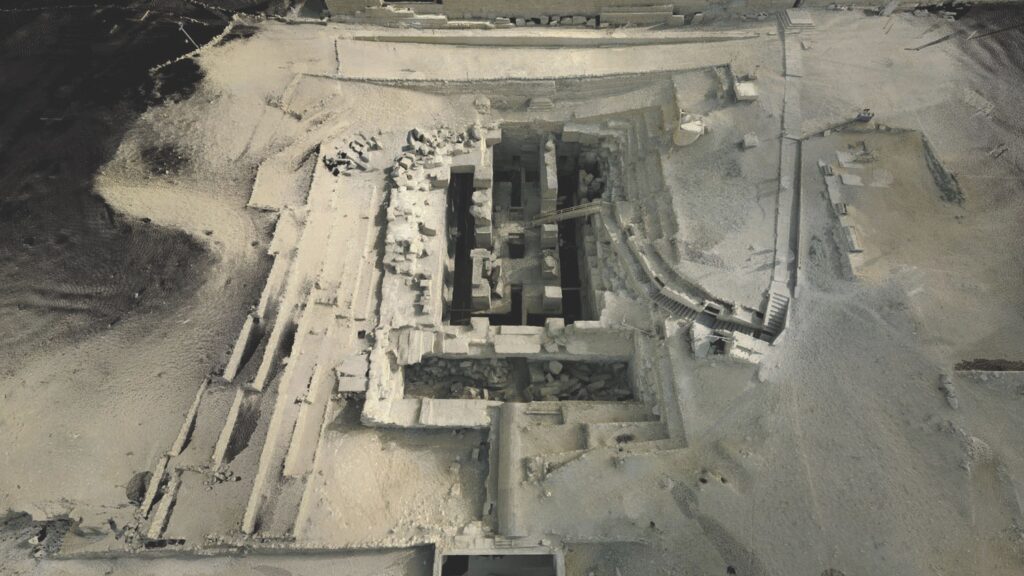
The Osireion Mystery: First Encounters and Early Questions
Have you ever stumbled onto the Osireion at Abydos and felt it deep in your gut — this doesn’t belong here?
You’re standing behind the grand temple of Seti I at Abydos.
Before you, sunken into the earth, lies a hidden world:
a hall of massive megalithic granite blocks, silent, flooded, strangely raw.
No colorful reliefs.
No ornate inscriptions.
No flourish of the 19th Dynasty.
Just sheer megalithic power — untouched, unsoftened, unapologetic.
It doesn’t look New Kingdom.
Some say it doesn’t even look Egyptian.
It looks ancient.
Lost Civilization ancient.
This is the Osireion — one of the strangest and most misunderstood megalithic monuments in all of ancient Egypt.
For over a century, the Osireion has defied easy explanation.
But when you follow the clues hidden within its stones,
the real story is even more astonishing than the myths.
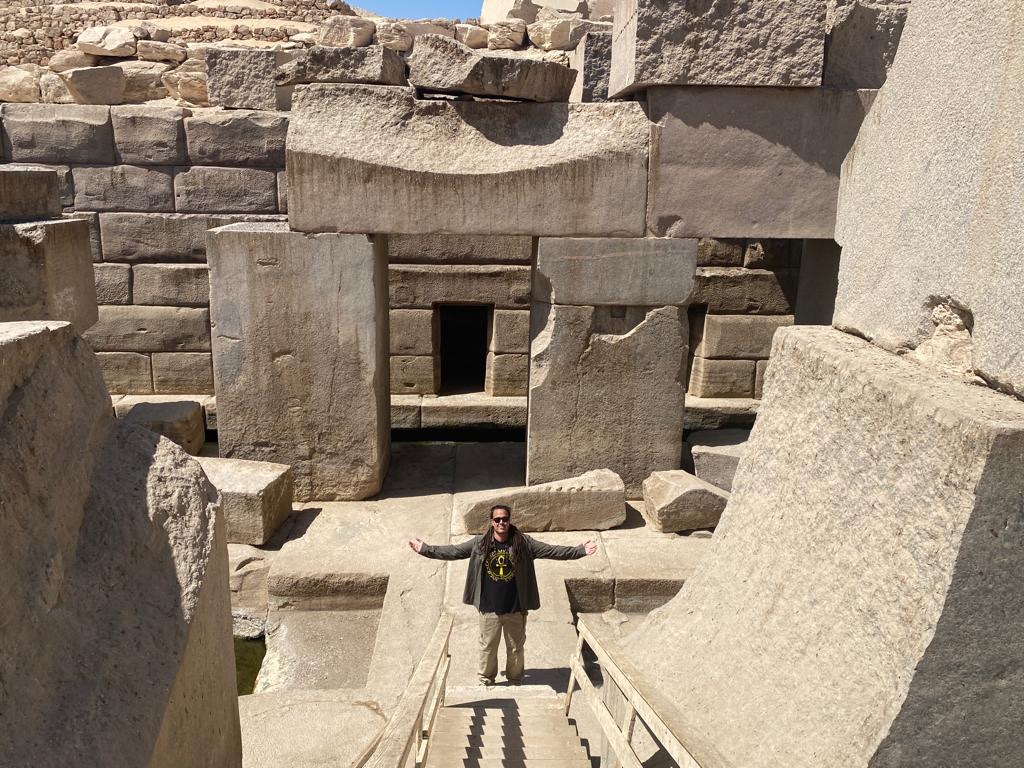
My First Encounter With the Osireion
I first encountered the Osireion during an intensive study tour with my mentor, John Anthony West —
the symbolist author who challenged the accepted history of the Great Sphinx,
and whose work opened the door to re-examining Egypt’s deeper mysteries.
But even then, standing among those monolithic stones, questions gnawed at me:
How could something so ancient-looking belong to the New Kingdom?
How could Egyptologists say this belonged to Seti I?
I had a deep feeling it was older — older than the textbooks claimed — but there was a problem.
The public assumption makes sense at first glance:
the Osireion’s massive granite blocks remind people of the Old Kingdom monuments at Giza —
especially the Khafre Valley Temple, with its colossal megalithic style.
It looks ancient.
It feels ancient.
And yet, Egyptologists confidently date it to the 19th Dynasty — the New Kingdom.
That contradiction gnawed at me.
When clients on my Adept Expeditions tours would ask,
“How can they say this belongs to Seti I?”
I realized I couldn’t give a complete answer.
I didn’t pretend to know.
And when I don’t know something, I go out and find it.
That’s exactly what I set out to do — to dig deeper, question everything, and uncover the real story of the Osireion for myself.
Because I realized most people didn’t know… and truthfully, neither did I.
Now that I do — I can finally share it with you.
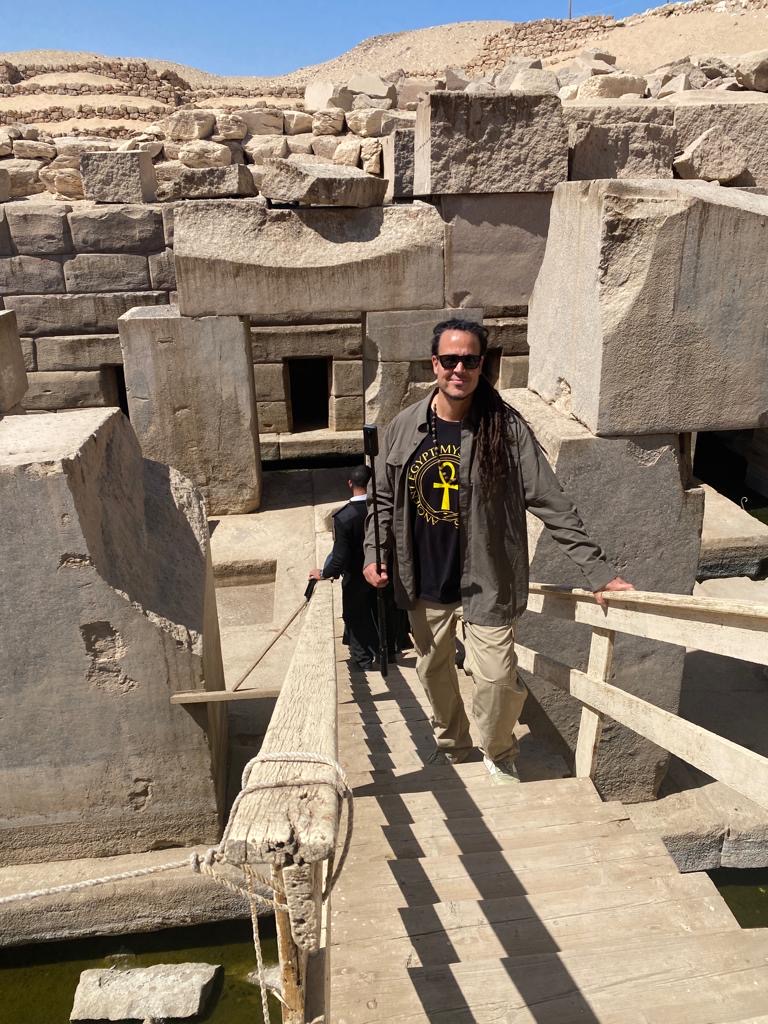
Rethinking What We Thought We Knew
Seeking Answers: How Egyptologists Uncovered the Osireion Mystery
Seeking real answers meant going beyond assumptions — and into the archives.
Living just minutes from the Theban Mapping Project Library in Luxor, gave me rare access to resources that most visitors never see.
It was there I met Dr. Kent Weeks —
the Egyptologist who discovered KV5, the largest tomb in the Valley of the Kings.
Dr. Weeks didn’t dismiss the Osireion as an out-of-place anomaly.
Instead, he framed it as a profound example of 19th Dynasty architecture consciously reaching back to earlier mythic traditions.
He pointed me toward primary excavation reports, overlooked publications, and archival material not easily available to the public.
I learned that real answers aren’t always obvious —
sometimes they’re buried in books.
And that’s where the real investigation began.
Excavating the Osireion: A Century of Changing Interpretations
The deeper I went, the more I realized the story of the Osireion wasn’t just about the stones —
it was about the shifting interpretations across generations of researchers.
Each excavation revealed new pieces of the puzzle — and sometimes corrected old assumptions.
It began in 1902, when Flinders Petrie first noticed a strange depression behind the Temple of Seti I.
Shortly after, his wife Hilda Petrie and Margaret Murray took charge of the work, uncovering what they initially believed to be an unusual symbolic tomb — a cenotaph for Osiris.
Their excavation was important, but incomplete — they never fully cleared the central hall.
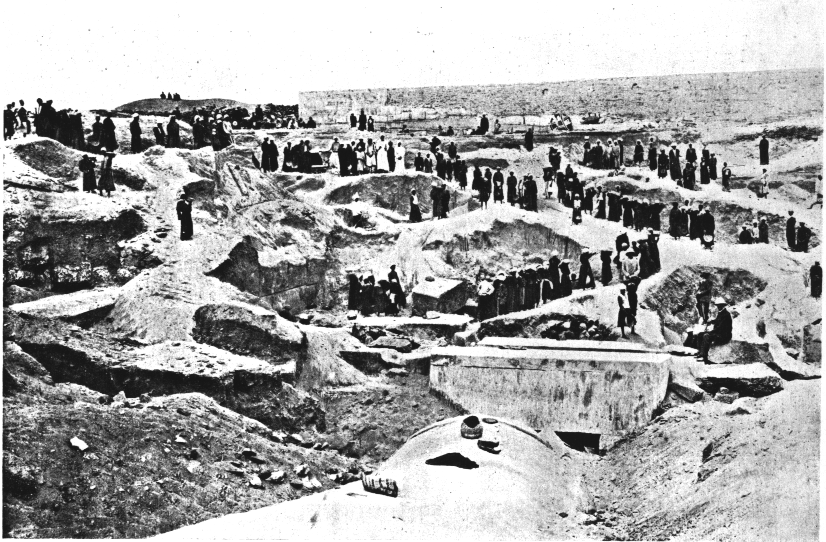
A decade later, Swiss archaeologist Édouard Naville returned with a larger workforce.
Unlike Margaret Murray’s earlier efforts, Naville succeeded in fully clearing the central hall of the Osireion for the first time. Standing amid the massive granite pillars and stark construction style, he was immediately struck by its resemblance to Old Kingdom monuments.
As Keith Hamilton notes, proponents of an earlier construction often cite Naville’s bold claim:
“I have no hesitation in putting the date of its erection to the time of the Old Empire, the IVth Dynasty, when the temple of the Sphinx was built, and perhaps even earlier. It is not impossible that this is the oldest Egyptian building, of large proportions, which has been preserved.”
Édouard Naville Tweet
However, Naville’s conclusion was based largely on visual resemblance, not careful excavation or stratigraphic analysis.
It would take the systematic work of Henri Frankfort and the Egypt Exploration Society a generation later to truly uncover the Osireion’s story from the ground up.

Then, in 1925, Henri Frankfort of the Egypt Exploration Society re-excavated the entire Osireion systematically.
Frankfort recorded everything — stratigraphy, tool marks, construction layers — and demonstrated that the Osireion belonged solidly to Seti I’s time.
Later still, figures like Omm Sety (Dorothy Eady) kept the Osireion alive in popular memory,
while Egyptian and foreign missions continued limited studies through the late 20th and early 21st centuries.
More recently, researcher James Westerman has raised new questions about what lies beneath —
suggesting there may be deeper levels still unexplored.
The story of the Osireion isn’t static.
It’s a living investigation —
and every generation peels back another layer of mystery.
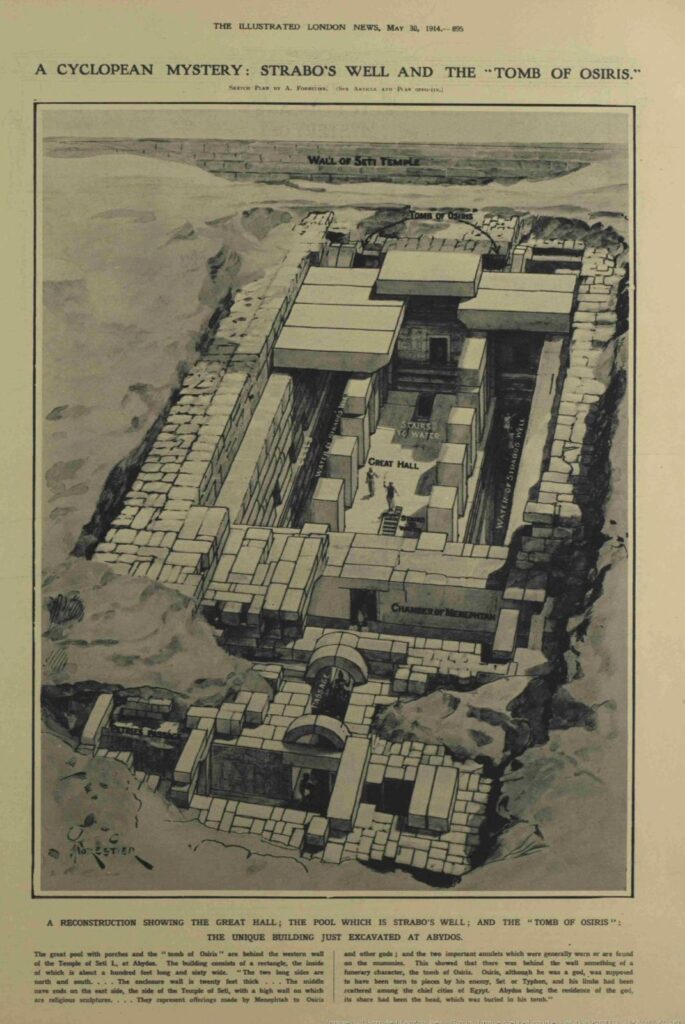
Generations of Theories, One Evolving Mystery
Clues Hidden in the Entrance: The Osireion's Design Secrets
Before we dive into the physical evidence,
we need to clear up a critical point most visitors — and even some researchers — overlook.
The Osireion isn’t a temple.
Its layout, symbolism, and architectural features point unmistakably toward a funerary function — much more like a tomb than a temple.
But here’s the problem:
most people only experience the Osireion either from high above, looking down, or — if you’re lucky enough to have a special permit like those granted to our Adept Expeditions tours — by descending modern stairs into the central hall.
Neither of these perspectives matches how the ancients intended the monument to be entered.
And when you don’t follow the intended path, you miss the monument’s real meaning.
The ancients designed a psychological and symbolic journey —
one that began not by dropping into the center, but by entering from the west, moving deliberately toward the heart of creation.
And here, we find our first clues.
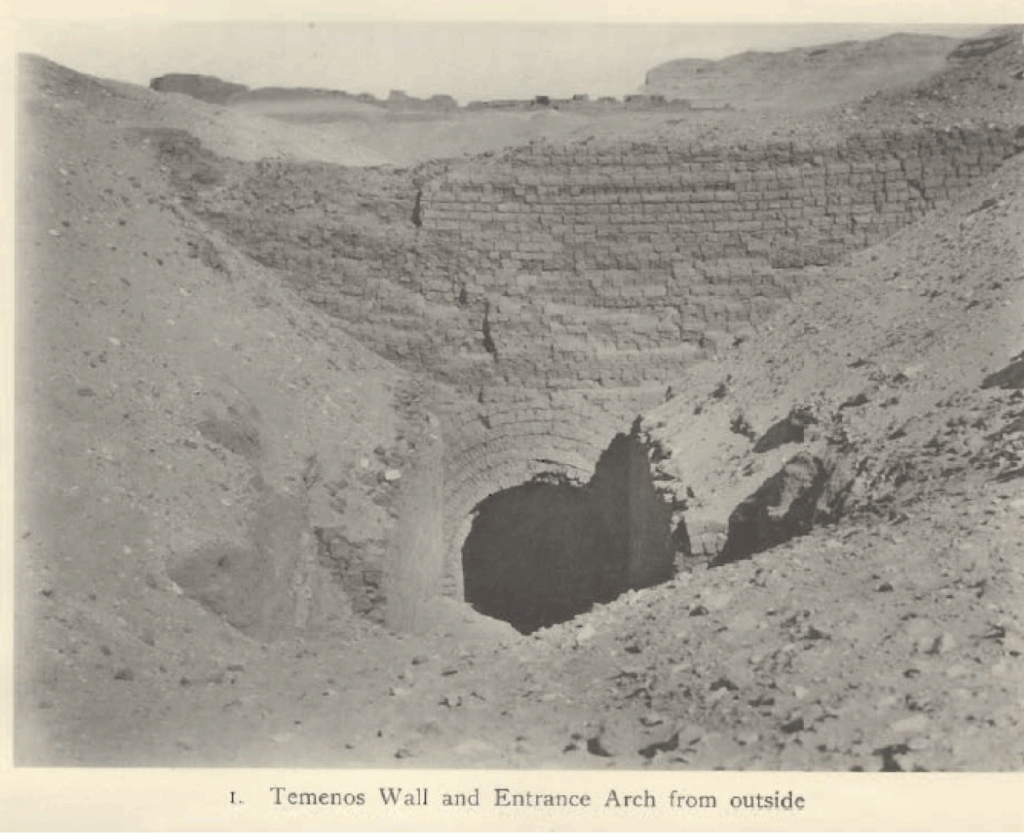
Symbolism of the Western Entrance
This isn’t random engineering — it’s an intentional act of sacred architecture, designed to guide initiates symbolically from chaos into divine order.
The entrance from the west was no accident, either.
In Egyptian cosmology, the west was associated with death, transition, and the setting sun —
the movement from visible life into the hidden realms.
As Egyptologist Jan Assmann explains:
“The gate is the most pregnant symbol of transition. It marks the passage from non-being to being, from the chaotic to the ordered.”
The entrance sequence of the Osireion isn’t just architectural —
it’s cosmological.
From formlessness into form, from death into rebirth, and from chaos into divine order, the Osireion’s symbolism reveals a journey of transformation.
On the right-hand wall — scenes from the Book of Gates.
The left — scenes from the Book of Caverns.
Both funerary texts designed to guide the king’s soul through the Duat.
And kneeling along this passage is a figure unmistakably carved in the New Kingdom style —
a pharaoh making offerings to Atum, the creator god, at the moment of creation itself.
This isn’t the architecture of a gathering place.
It’s the architecture of rebirth.
And it’s only the beginning of the clues the Osireion holds.
Hidden Clues in the Osireion
But before we reach the Central Hall and the heart of the Osireion investigation, there’s a subtle yet crucial stop along the way—a small, easily overlooked chamber and its annex at the end of the entrance corridor.
As we step inside, the corridor suddenly makes a sharp, right-angle turn—a deliberate pivot descending even deeper into the earth.
This architectural feature isn’t random.
We’ve seen this exact design before, typically in royal tombs from Egypt’s New Kingdom.
These sharp, right-angle turns served a critical practical purpose: ancient priests, bearing a heavy sarcophagus through narrow corridors, needed these chambers as turning points. The presence of such a chamber here is another strong clue reinforcing the Osireion’s funerary—not temple—function.
But that’s not all.
On the walls of this seemingly insignificant chamber, we find another key detail: an inscription bearing Seti’s royal name—but strangely, not enclosed in a cartouche.
It’s an easy thing to miss—and apparently, Merneptah’s artisans did exactly that. They must have been scanning for the typical royal oval (cartouche) and overlooked Seti’s plain hieroglyphic signature.
Yet, even in oversight or partial erasure, the Pharaoh endures, quietly confirming Seti’s presence here.
The walls further show Horus offering to Osiris, reinforcing the chamber’s sacred and funerary nature.
But why is this chamber truly significant?
Because it was here that two of the three major ritual cycles associated with the Osireion would have reached their conclusion.
The Osireion was not simply built and abandoned.
It was actively used in complex cycles of sacred ritual:
1.) Nightly cycle—symbolizing the Sun God Ra’s journey through the Duat (underworld).
2.) Monthly cycle—linked to lunar regeneration and rebirth rites associated with the new moon.
3.) Annual cycle—dedicated to the renewal of divine kingship through the symbolic union of Isis and Osiris—this third cycle culminated in the Central Hall itself, which we’ll enter next.
Thus, this small, forgotten room holds monumental significance.
It wasn’t merely a turning point for sarcophagi.
It was a sacred transition point, a space where cosmic cycles came to completion.
And now, fully prepared, we step forward into the Central Hall—the true heart of our Osireion investigation.
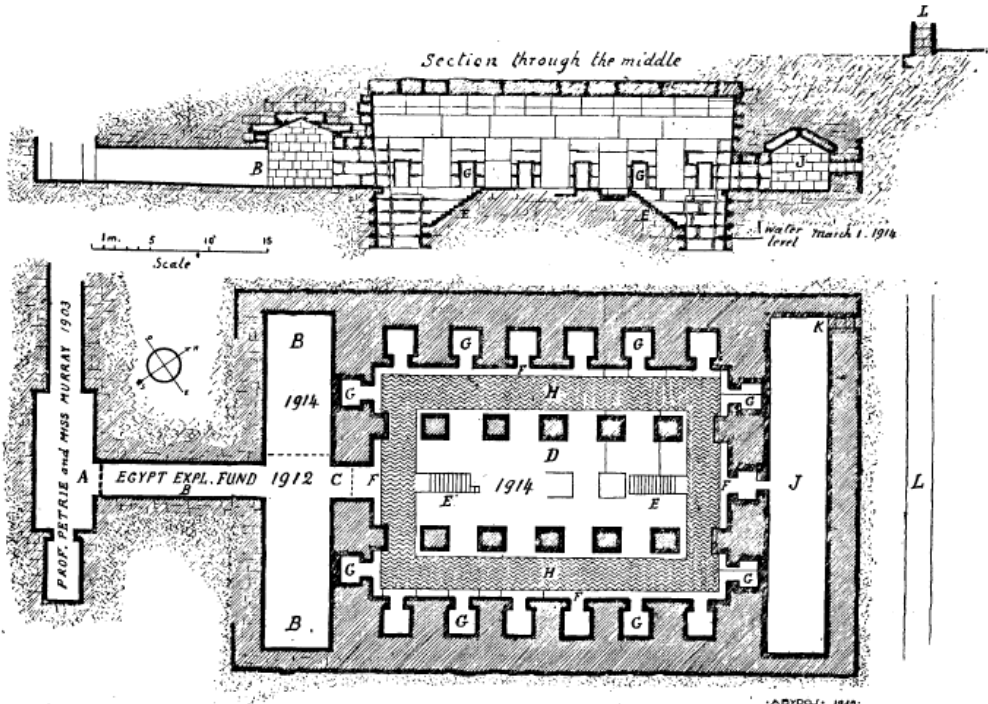
Stepping Into the Osireion Central Hall: Evidence in Stone
Standing on the sandstone podium at the heart of the Osireion, you feel its mysterious grandeur around you. The massive granite pillars tower silently, and while they may feel ancient and powerful, they are often deeply misunderstood.
But before we even entered the hall, the Osireion was already whispering clues to those willing to listen.
Uncovering the Hidden Evidence of the Osireion
🔎 Clue #1: The Sealed Mudbrick Entrance
At the original processional entrance through the Temenos wall, archaeologists discovered a wall of mudbrick—sealed, intact—and stamped with the cartouche of Seti I himself.
This wasn’t random debris. It was deliberate.
Seti didn’t just build the Osireion. He sealed it, protected it, and left his royal mark at the threshold — hidden in plain sight.
This was our first clue — but far from our last.
🔎 Clue #2: Granite Over Sandstone
Beneath your feet, the podium itself is sandstone—a crucial but easily overlooked clue. Many visitors insist the Osireion must be far older than Seti I because of these enormous granite pillars, reminiscent of Old Kingdom monuments like the Khafre Valley Temple. But there’s a significant oversight in this assumption: the granite pillars rest directly upon sandstone flooring.
Here’s the critical point: Egyptians didn’t commonly use sandstone for flooring until at least the Middle Kingdom. It became particularly popular in the New Kingdom, precisely during Seti’s 19th Dynasty. Thus, the granite pillars people associate with Old Kingdom style actually sit atop material clearly indicating a later date.
This detail is further supported by Archaeologist Dieter Arnold, who notes:
"Limestone and sandstone were the great building stones of ancient Egypt. Limestone was typically used for constructions dating from the Third Dynasty to the Middle Kingdom and the early New Kingdom. Sandstone began to be used in the Eleventh Dynasty but became a common building stone from the Eighteenth Dynasty on."
Dieter Arnold Tweet
In other words, the Osireion’s sandstone foundation is not an anomaly—it fits perfectly within the architectural practices of Seti I’s era.
🔎 Clue #3: The Integrated Construction
If the sandstone flooring isn’t enough evidence, look up. Above the granite pillars lie massive granite architraves, and atop these, granite roof beams. Though much of the ceiling is now gone, traces remain in the northeast corner, with granite beams still projecting firmly from the sandstone walls. Around the central hall, seventeen chambers—limestone cores protected externally by sandstone blocks—form an integrated, interlocking design. This is not patchwork or repurposed masonry; this is one cohesive plan, carefully executed as a single, deliberate construction.
🔎 Clue #4: The Hidden Cartouche on a Dovetail Clamp
How do we know the Osireion wasn’t merely inherited from some earlier civilization, but purpose-built by Seti I?
Here’s where we find one of our strongest clues — hidden not in plain sight, but deep within the stone itself.
During his re-excavation, Henri Frankfort noticed something unusual:
a chip in the northwest wall exposed a sliver of an internal dovetail clamp — a specialized joint carved directly into the stones, locking massive blocks together like an ancient, invisible puzzle.
Curious, Frankfort reached his hand deep inside the narrow cavity — feeling carefully, blindly — like reading ancient braille by touch.
"I consequently looked for confirmation of our find and noticed another dovetail, which could just be seen where in the backing wall one of the blocks had accidentally flaked off. It was in the third course from the top, where the granite roofing slabs were still in position, and where the granite architrave was worked into the fabric of the quartzite-sandstone backing wall, a spot where the building is so well preserved that there can have been no tampering with the dovetails. We erected a scaffolding, chiselled away about half an inch of the broken surface, and could both see and feel a deeply cut cartouche. So no doubt remained. The hidden stones had at last revealed the founder"
Henri Frankfort Tweet
And there, in the dark, carved onto the hidden dovetail clamp, he found it:
A royal cartouche.
The name of Seti I, sealed into the core masonry — unseen, unreachable, unless deliberately excavated.
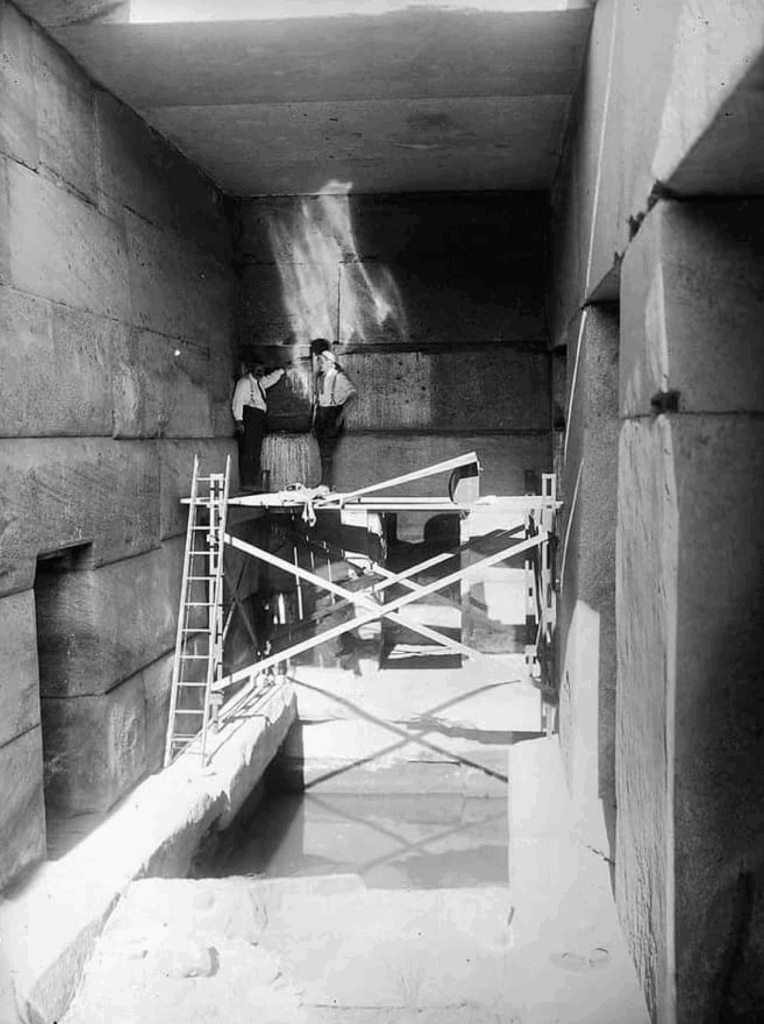
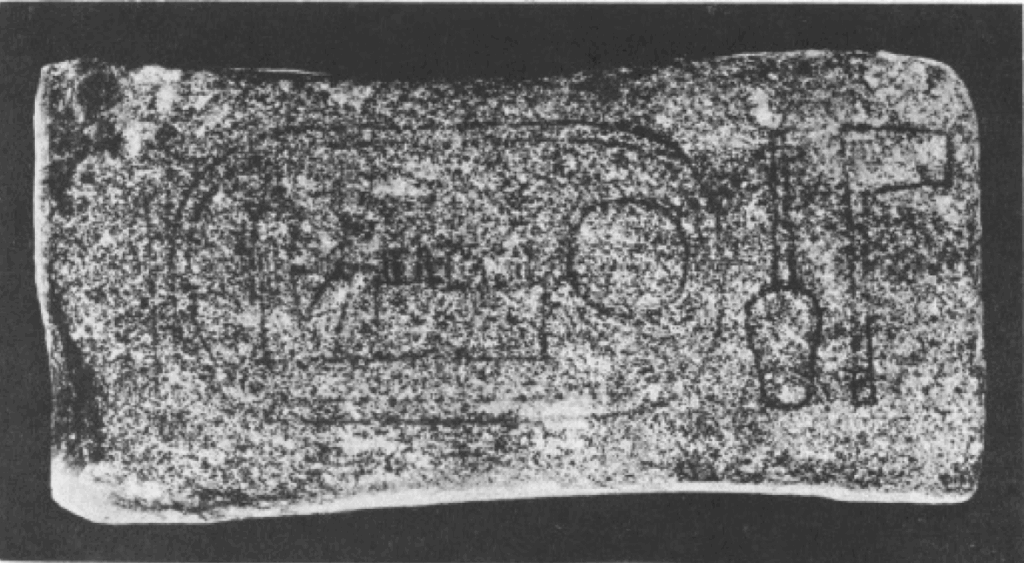
This wasn’t casual graffiti to stake a later claim.
It wasn’t a monument usurpation to boast lineage.
This was something different — and far more telling:
➔ Seti’s mark was hidden inside the very core masonry of the Osireion.
➔ Not meant to be seen.
➔ Not meant to be glorified.
➔ Meant only to exist — quietly — at the foundation of the monument itself.
Other dovetail clamps with Seti’s name were later found above the entrance lintel and other blocks, confirming the pattern.
In short:
Seti didn’t brand the Osireion to proclaim ownership.
He built it — and sealed his legacy deep within the stone.
🔎 Clue #5: Official Construction Records
And there’s more. Ostraca—inscribed pottery shards—dating unmistakably to the 19th Dynasty record official construction activities at the site. These shards mention Menmaatre (Seti’s throne name) explicitly, documenting the hauling of various types and sizes of stone blocks from the temple’s harbor to the construction of “Beneficial is Menmaatre for Osiris,” the ancient name for the Osireion. The records specify the stone blocks were large enough that only a few could fit per transport boat—further corroborating the immense scale of construction.
🔎 Clue #6: A Lack of Older Artifacts
Moreover, every artifact found during excavation dates from the 19th Dynasty or later. Nothing older—no remnants from an Old Kingdom or a lost civilization—has ever surfaced here. The archaeological record is clear: Seti I constructed the Osireion from the ground up during his reign.
🔎 Clue #7: Seti the Renaissance Builder
Historically, Seti I was known as a renovator, a renaissance builder who proudly inscribed his restorations with a specific text called “sema-menu.” Yet no such inscriptions appear at the Osireion—further evidence that this wasn’t a restoration. It was a completely new, deliberate, original build.
🔎 Clue #8: A Detailed Hieroglyphic Program
Contrary to common claims, the Osireion is decorated with hieroglyphs. In the transverse hall and the entrance corridor, hieroglyphic inscriptions completed by Seti and later by Merenptah describe detailed funerary and ritual contexts. Most notably, the Litany of Re inscribed on the massive granite architraves aligns with funerary symbolism, clearly situating the monument within an active ritual framework.
🔎 Clue #9: Later Priestly Graffiti and Ritual Confirmation
Adding further weight, priests from the 21st and 22nd Dynasties left graffiti referencing this space explicitly as the subterranean “realm of Menmaatre,” reaffirming the funerary function and calling the central hall “The Birth House of Isis.” This explicitly indicates its role in the third ritual cycle—the divine rebirth of Horus, the living king, conceived through Isis and Osiris. Importantly, these inscriptions also give us the ancient name for the Osireion—”Beneficial is Menmaatre (Seti I) for Osiris,” clearly linking the structure directly to Seti I himself.
The relief carvings here differ significantly from typical tomb scenes; rather than offerings made to the deceased king, the Osireion depicts the living king making offerings to the gods, underscoring its unique and intentional ritual design.
🔎 Clue #10: The Grand Finale - The Ancient Ramp Discovery (2023)
And finally, recent restoration work on the Osireion in 2023 revealed a monumental ramp carved into the bedrock. This ramp is a testament to the detailed construction records found on ostraca. Remarkably, the ramp perfectly accommodates the largest stones used in the build, including the colossal megalithic granite blocks. Crucially, nothing found above or below the ramp predates the 19th Dynasty. This discovery firmly suggests that during Seti’s reign, Egyptian engineers not only hauled but also erected some of the largest megalithic granite blocks in the entire history of ancient Egyptian civilization.
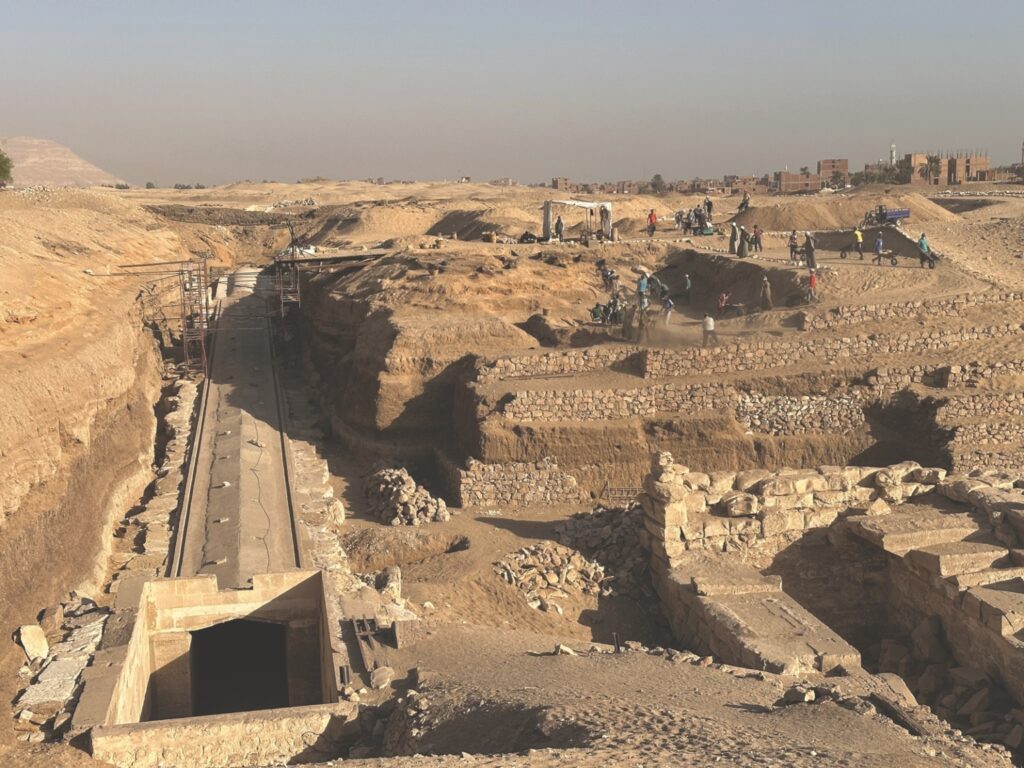
🔎 Comparing Evidence: Correcting Misinterpretations
When this robust evidence is weighed against Edouard Naville’s surface observations, his arguments simply do not hold up. Even Naville himself acknowledged that the blocks at the Osireion were larger than those at the Khafre Valley Temple. Comparing a temple structure to this unique funerary monument based solely on large granite stones is insufficient. Furthermore, detailed scrutiny reveals the layout of the Osireion aligns with 18th Dynasty royal tombs—mirroring those of Thutmose III, Amenhotep II, and Thutmose IV. The distinctive arch on the main façade also reflects design elements characteristic of the 19th Dynasty, employed by Seti and Ramses II, further confirming its New Kingdom origin.
The Flower of Life At the Osireion: Myth, Mystery, and Misunderstanding
If you’ve heard of the Osireion, there’s a good chance it was because of the so-called “Flower of Life” —
a sacred geometrical image, overlapping circles found on the granite pillars.
Some say they are ancient inscriptions that prove the Osireion dates back to a lost civilization.
Others believe they’re the fingerprints of ancient lost technology.
But what’s the real story?
Let’s take a closer look.
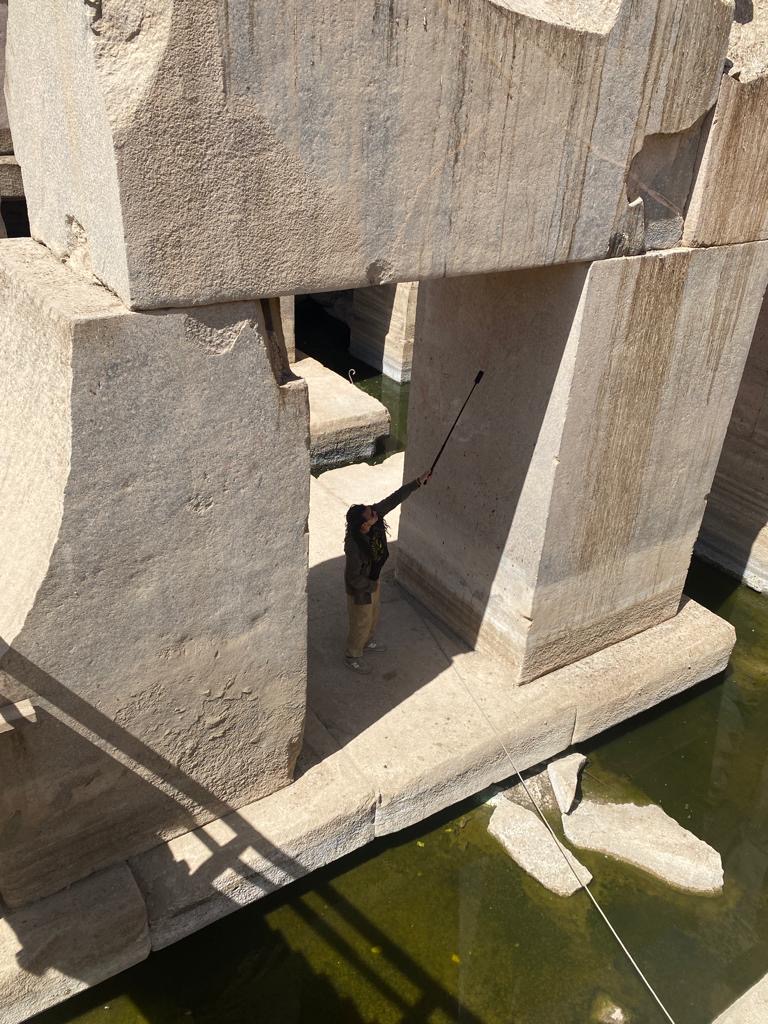
Looking Deeper at the Flower of Life Mystery
When you stand inside the Osireion — not just looking from above, but truly inside its granite core —
you notice something most tourists miss:
There isn’t just one Flower of Life pattern.
There are several — scattered across multiple pillars, at different heights, sizes, and levels of finish.
- Some are deeply etched.
Others are faint, like scratched graffiti.
A few are so light, you’d miss them entirely unless the sunlight hit them just right.
What’s even more telling?
These Flower of Life patterns:
– Aren’t mentioned in any ancient inscriptions nearby.
– Aren’t part of the official decorative program Seti I commissioned.
– Aren’t referenced in the Book of Caverns or Book of Gates scenes around them.
In fact, there is no known precedence for the Flower of Life in ancient Egyptian art or iconography.
That doesn’t make them meaningless.
But it suggests something crucial:
they were likely added later — maybe centuries, or even millennia after the original construction.
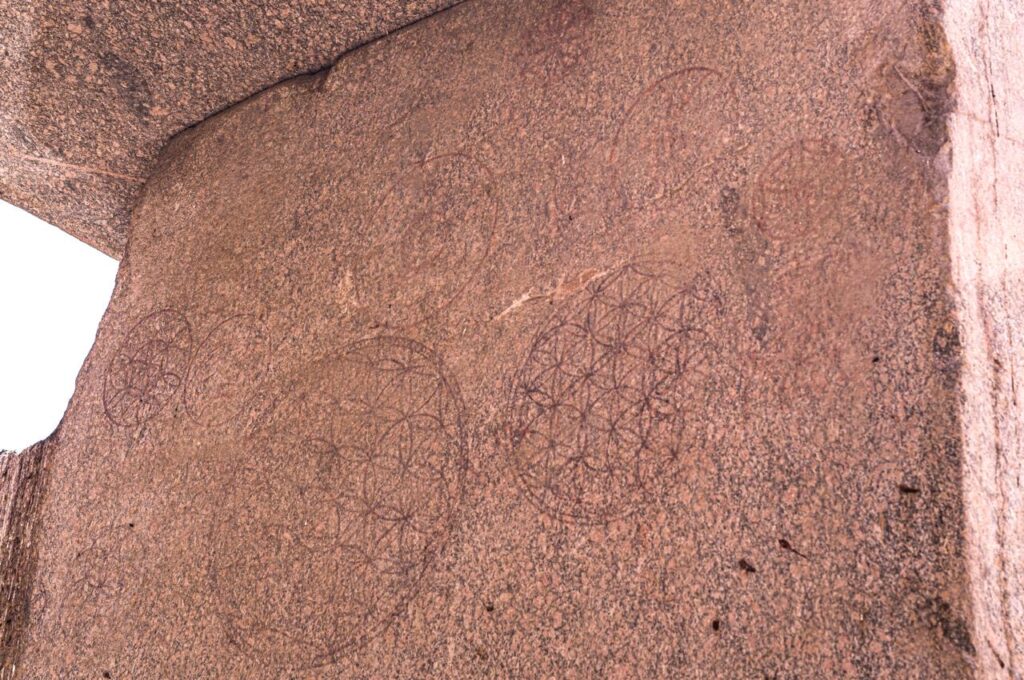
An Invitation, Not a Disappointment
Could they still hold deeper wisdom?
Maybe.
Sacred geometry has ancient roots, and Egypt was a master of encoding cosmic principles into stone.
But when it comes to the Flower of Life at the Osireion, we must be honest:
Their age, their meaning, and their original purpose remain unproven.
That’s not a disappointment.
It’s an invitation — an invitation to approach these symbols with fresh eyes, with wonder, and with the careful mind of an Adept.
The Adept Initiate’s Guide to the Osireion
The Adept Initiate’s Guide to the Osireion: Experiencing the Birth House of Isis Using the Esoteric Symbolist Approach.
For the first time, ancient Egypt’s most misunderstood monument will be explored through the lens of firsthand investigation, Egyptological research, and the esoteric tradition that once guided initiates along the sacred path.
Ready to step deeper into the mystery?
✨ Join the VIP list below to be among the first to receive early access — plus exclusive bonuses reserved only for fellow seekers.
The Osireion's True Story Revealed
For over a century, the Osireion has invited speculation — but the real story, hidden in stone and stratigraphy, is even more profound.
Seti I wasn’t restoring a lost civilization. He was reviving cosmic myth through sacred architecture, leaving behind one of the most stunning, misunderstood megalithic monuments in Egypt.
And now, you know the evidence.
You know how to see the Osireion for what it truly is.
But to really understand it — to feel it — you have to experience it.
Join me, Anyextee, on an Adept Expeditions tour, and step inside the hidden heart of the Osireion yourself.
(Only a handful of groups each year are granted this special VIP access.)
Want even more? Discover hidden Egypt with Anyextee’s Esoteric Egypt Tours, including rare VIP access to the Osireion.
Sources and Further Reading
For those who want to dive deeper into the Osireion’s history and the evidence discussed here, I recommend exploring these primary and scholarly sources:
- Margaret Murray, The Osireion at Abydos (1903) — Early excavation reports and symbolic interpretation.
- Flinders Petrie, Abydos II (1903) — Original documentation of Seti I’s temple and surrounding structures.
- Edouard Naville, The Osireion at Abydos (1914) — Early interpretations (and misinterpretations) of the site.
- Henri Frankfort, The Cenotaph of Seti I at Abydos (1933) — The definitive excavation correcting earlier theories.
- Peter Brand, The Monuments of Seti I (2000) — Comprehensive modern analysis of Seti I’s architectural legacy.
- Dieter Arnold, Building in Egypt: Pharaonic Stone Masonry (1991) — Detailed study of ancient Egyptian building materials and methods, including the evolution of sandstone use.
- Keith Hamilton, A Layman’s Guide to the Osireion (2022) — Accessible analysis bridging scholarly and popular perspectives.
- Charles Herzer Jr., The Study of the Osireion at Abydos (2023) — The most exhaustive modern investigation into the Osireion’s construction, symbolism, and architectural history.
- James Westerman, Proposed Substructures Beneath the Osireion (1986–2023) — New theories and research into the Osireion’s subterranean features.
-
The Theban Mapping Project — Resources on New Kingdom tombs and symbolic funerary architecture. (🔗 Theban Mapping Project)